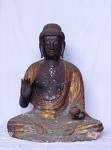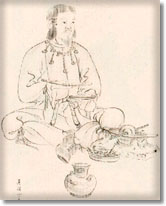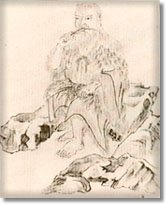:::::::::::::::::::::::::::::::::::::::::::::::::::::::::::::::::::::::::::::::::::::::::::::::::::::
Yakushi Nyorai 薬師如来 Bhaisajyaguru
the Buddha of Medicine and Healing

- source : Shin Yakushi-Ji 新薬師寺
His ennichi 縁日 "Sacred Day" is the eighth of every month.
- - - - - My Articles about Yakushi Nyorai - - - - -
. Yakushipedia - - ABC-Index - all articles .
. Yakushi Nyorai - Legends from the provinces .
:::::::::::::::::::::::::::::::::::::::::::::::::::::::::::::::::::::::::::::::::::::::::::::::::::::::::::::::::::::::::::
- - - - - My friend Mark Schumacher has all the details.
Yakushi Nyorai - YAKUSHI TATHĀGATA
Yakushi’s full name is Yakushi-rurikō 薬師瑠璃光,
Lord of the Eastern Paradise of Pure Lapis Lazuli
Medicine Master of Lapis Lazuli Radiance.
Introducing the features of Yakushi Nyorai, the important statues and temples.
:::::::::::::::::::::::::::::::::::::::::::::::::::::::::::::::::::::::::::::::::::::::::::::::::::::::::::::::::::::::::::

. Yakushi Nyorai Pilgrimages - Introduction .
Juuni Yakushi meguri 十二薬師巡り Juni Yakushi Meguri
Juuni Yakushi Reijoo Meguri 十二薬師霊場巡り Juni Yakushi Reijo Meguri
:::::::::::::::::::::::::::::::::::::::::::::::::::::::::::::::::::::::::::::::::::::::::::::::::::::::::::::::::::::::::::
Temple Yakushi-Ji 薬師寺

one of the most famous imperial and ancient Buddhist temples in Japan, located in Nara. The temple is the headquarters of the Hossō school of Japanese Buddhism. Yakushi-ji is one of the sites that are collectively inscribed as a UNESCO World Heritage Site.
The main object of veneration, Yakushi Nyorai, also named "The Medicine Buddha", was one of first Buddhist Deities to arrive in Japan from China in 680, and gives the temple its name.
© More in the WIKIPEDIA !

. . . CLICK here for Photos !
:::::::::::::::::::::::::::::::::::::::::::::::::::::::::::::::::::::::::::::::::::::::::::::::::::::::::::::::::::::::::::
Three famous regional Yakushi Temples
Shimane Prefecture, Ichihata Yakushi
島根県 一畑薬師(いちはたやくし)
Ichibata Yakushi. Ichi Hatayama
Yakushi who treats eye diseases.
. . . CLICK here for Photos !
Fukuoka ken, Kurume, 永勝寺 Eisho-Ji
福岡県久留米市 柳坂山 永勝寺 (りゅうばんざん えいしょうじ )
. . . CLICK here for Photos !
. Ehime Prefecture, Yamada Yakushi 愛媛県宇和町 山田薬師 .
now : 小野薬師 Onoyama Yakushi
:::::::::::::::::::::::::::::::::::::::::::::::::::::::::::::::::::::::::::::::::::::::::::::::::::::::::::::::::::::::::::
. . . . . . H A I K U

夕涼や薬師の見ゆる片小藪
yuusuzu ya Yakushi no miyuru kata koyabu
evening coolness -
the Buddha of Medicine
in a little thicket
Kobayashi Issa
一茶発句全集
..................................................................................................
Statue at temple Toogan-Ji 東岸寺Chiba Prefecture, Kisarazu
with Haiku by Issa
:::::::::::::::::::::::::::::::::::::::::::::::::::::::::::::::::::::::::::::::::::::::::::::::::::::::::::::::::::::::::::
Matsuo Basho wrote his famous haiku about silence and the cicadas at this temple, where a famous statue of Yakushi Nyorai is venerated, said to have been carved by Kobo Daishi himself.

Yamadera in Yamagata Province and Haiku
Medicine Buddha of Tibet
:::::::::::::::::::::::::::::::::::::::::::::::::::::::::::::::::::::::::::::::::::::::::::::::::::::
first visit to a Yakushi temple
kigo for the New Year
January 8, on the Monthly Day of Yakushi Nyorai
日溜りに猫のゐ眠る初薬師
hidamari ni neko no inemuru hatsu Yakushi
in a sunny spot
a cat sound asleep -
first Yakushi visit
© Fuuten Tora
***** Saijiki of Japanese Ceremonies and Festivals
:::::::::::::::::::::::::::::::::::::::::::::::::::::::::::::::::::::::::::::::::::::::::::::::::::::
observance kigo for mid-spring

Yakushiji eshiki 薬師寺花会式 (やくしじはなえしき)
Ceremony of flowers at temple Yakushi-ji
..... Yakushiji zooka e 薬師寺造華会(やくしじぞうかえ)
artificial flowers from Yakushiji temple
hana eshiki 花会式(はなえしき) "ceremony of flowers"
quote
A ceremony, called Hana-e-shiki, is held in honor of Yakushi every year
from March 30th to April 5th at the Yakushi-Ji temple.
Hana-e-shiki is a Buddhist rite of praying to the Buddha of Medicine for the peace of the country, for good crops, and for happiness and prosperity of the entire nation. This ceremony, called Shuni-e in the olden times, was held in February every year.
In 1107 Emperor Horikawa offered sacred flowers to the Healing Buddha in commemoration of his Consort's complete recovery from an illness. This incident led to the annual event of offering artificial flowers, which is "Hana-e-shiki," or the memorial service of flowers.
Later this offering of flowers was added to the Shuni-e rituals, and the whole ceremony came to be popularly called "Hana-e-shiki." The frontal part of the main hall's altar, where the main object of worship is enshrined, is decorated with 10 kinds of artificial flowers:
plums, peaches, Japanese roses, camellias, rabbit-ear irises, lilies, chrysanthemums, cherry blossoms, wisterias and peonies.
source : www.uwec.edu. Suzanne Bodoh
:::::::::::::::::::::::::::::::::::::::::::::::::::::::::::::::::::::::::::::::::::::::::::::::::::::
plant kigo for early autumn

Yakushisoo, yakushi soo 薬師草(やくしそう)
"Yakushi plant"
..... otogirisoo 弟切草 (おとぎりそう)
"killing the younger brother - plant"
Youngia denticulata
It grows on sunny slopes in high mountains.
A famous falconer of the Heian period, Haruyori 晴頼, used it to heal the wounds of his animals. It helps with bleeding wounds. It was a secret of his family and not to be leaked outside. But his younger brother tried to sell the secret for a bit of money. His angry brother killed him on the spot,when he learned about this.
:::::::::::::::::::::::::::::::::::::::::::::::::::::::::::::::::::::::::::::::::::::::::::::::::::::
temple in summer -
the power of healing
in prayer and stone
Yakushi Nyorai no tsubo 薬師如来の壺 medicine jar
medicine jar 薬壺のお守り

source : http://blog.livedoor.jp/katayamazu
from temple 愛染寺, Aizen-Ji 片山津 Niigata

source : www.araiyakushi.or.jp
from temple Arai Yakushi 新井薬師 Baisho-In, Tokyo
東京都中野区新井5-3-5

source : www9.plala.or.jp/yumedono
Nagano, 長野県上田市下之郷541 - Choofukuji 長福寺 Chofuku-Ji Yumedono
- - - - -

source : item.rakuten.co.jp/hachimitu
to carry with you, wood carving
. Health Amulets 健康御守 kenkoo omamori .
:::::::::::::::::::::::::::::::::::::::::::::::::::::::::::::::::::::::::::::::::::::::::::::::::::::
. Ehime - temples with a Yakushi Nyorai
Kanjizaiji 「観自在寺」
http://www.kanjizaiji.com/
Jooruriji 「浄瑠璃寺」
http://www.88shikokuhenro.jp/ehime/46joruriji/index.html
Hantaji 「繁多寺」
http://www.88shikokuhenro.jp/ehime/50hantaji/index.html
Ishiteji 「石手寺」
http://www.88shikokuhenro.jp/ehime/51ishiteji/index.html
. Ishiteji 石手寺 Ishite-Ji . and Fudo Myo-O
Kokubunji 「国分寺」
http://www.88shikokuhenro.jp/ehime/59kokubunji/index.html
Zenpukuji 善福寺 Zenpuku-Ji
愛媛県今治市伯方町北浦甲1986-2 Imabara
:::::::::::::::::::::::::::::::::::::::::::::::::::::::::::::::::::::::::::::::::::::::::::::::::::::
[ . BACK to WORLDKIGO . TOP . ]
[ . BACK to DARUMA MUSEUM TOP . ]
:::::::::::::::::::::::::::::::::::::::::::::::::::::::::::::::::::::::::::::::::::::::::::::::::::::::::::::::::::::::::::
:::::::::::::::::::::::::::::::::::::::::::::::::::::::::::::::::::::::::::::::::::::::::::::::::::::::::::::::::::::::::::
. Sukunahikona no mikoto 少彦名命 Sukuna Hikona, Sukuna-Hikona .
Another Deity to protect the medicine is Shinno Sama and the Japanese Hikona.

Hikona 小彦名

Shinno shi 神農氏
These two deities are especially venerated in the district of Doshoo-Machi, where many pharmaceutical companies have their seat. During the annual Shrine Festival, people pray for good health.
http://www.kusuri-doshomachi.gr.jp/sinno/sinno.html
November 22 to 23 is the Shinno Festival
Sukunahikona Shrine (Chuo-ku, Osaka City).
小彦名神社
Sukunahikona Shrine enshrines a guardian god of Dosho-machi, Osaka's medicine town. During the Shinno Festival, people buy bamboo branches to celebrate the Buddha of Medicine.
Another item sold in honor of Shinno Sama as a token for good health is a small tiger made of papermachee.

「神農(じんのう)さん」と呼ばれているのは、道修町(どしょうまち)の小彦名(すくなひこな)神社のことで、ここに神農氏が共に祀られています。10センチ程の首振り式のこの張り子の虎は、11月22、23日の「神農祭り」に授与されます。
神農氏とは、中国の医薬神で、農耕を教え、薬草の効果を身をもって試み、医薬の道を説いた神さまです。
道修町は、薬品会社・薬品問屋の街です。神農さんの虎は神社の授与品と、この薬品問屋から配られるものの2種類があります。神社からだされるものは、虎の腹部に神農社の紋の「薬」の朱印が押されています。
江戸時代末期にコレラが流行しました。この時、「虎頭殺鬼雄黄丹」という丸薬の虎にちなんだ、張り子の虎を、小彦名神社に供えて病除祈願をし、それを配ったのが始まりとされています。
また、この製作者の所では、この虎の他に「節供飾りの虎」が作られています。全長57センチのものから11センチまで、8種類作られています。
大阪張り子は、かなり古くから作られていたようですが、大正から昭和の初期にセルロイドやブリキの玩具に押されて、作っていた家のほとんどが転廃業してしまい、現存の制作者は2人となってしまいました.
http://www.asahi-net.or.jp/~SA9S-HND/agal-958-1.html
Shinnoosai Shinnoo Festival 神農祭
神農祭は、毎年11月22~23日の2日間にわたり盛大に斎行(さいこう)されています。薬種商が店先に祭提灯や祝幕、金屏風を飾った戦前と、商店が会社に発展した戦後とでは、祭は大きく様変わりしましたが、薬業界の祭に寄せる心は変わることはありません。時代とともに年々参拝者が増加、今日では2日間で約5万人の参拝者で賑わい、“町の祭り”から“大阪の年中行事”の祭りに発展しました。神農祭が盛大であるため、当社の通称も“少彦名神社”より“道修町の神農さん”と称されています。また、昔から。大阪の一年の祭りは戎祭りで始まり当社の神農祭で終わるため、「とめの祭り」ともいわれ、薬業界の守護神として、人々の病除けの神として親しまれています。
More photos from the festival
安永9年(1780)10月。京都・五條天神宮から少彦名命をお迎えし、以前から祀っていた神農氏と共にお祀して、2000年にはご鎮座220年を迎えました。
大阪市中央区道修町2丁目1番8号
http://www.kusuri-doshomachi.gr.jp/event/sinnosai.html
. Tora トラ - 虎 - 寅 Tiger Toys .
:::::::::::::::::::::::::::::::::::::::::::::::::::::::::::::::::::::::::::::::::::::::::::::::::::::
Doshomachi Pharmaceutical & Historical Museum
Located on the grounds of Sukunahikona Shrine, where the god of medicine is enshrined, this museum shows how the entire Doshomachi district has developed along with the pharmaceutical industry for nearly 350 years. The exhibits include old documents such as address lists of medicine traders. Here, the development of the pharmaceutical industry and the history of Doshomachi, a pharmaceutical district, are laid out.
This facility is located on the grounds of Sukunahikona Shrine.
http://www.kanko-osaka.or.jp/eng/sight/sight.cgi?id=00195&func=course&cls0=false&cls1=5&cls2=1
:::::::::::::::::::::::::::::::::::::::::::::::::::::::::::::::::::::::::::::::::::::::::::::::::::::
. Mahayana Buddhist Healing Rituals .
Ji Hyang Padma
Core Faculty at California Institute for Human Science
:::::::::::::::::::::::::::::::::::::::::::::::::::::::::::::::::::::::::::::::::::::::::::::::::::::
. Yakushi Rurikoo Nyorai 薬師瑠璃光如来 Ruriko Yakushi .
- - - - - Ruriji 瑠璃寺 temples names Ruri-Ji
- - - - - Rurikooji 瑠璃光寺 temples names Ruriko-Ji - Rurikō-ji
- - - - - Rurizan (るりざん) 瑠璃山 Ruriyama
Yakushi Nyorai, Yakushi Rurikoo Nyorai
(Bhaishajya-guru)
"Buddha der Medizin und Heilung", daher auch "Großer Buddha der Medizin" genannt.
Lebt im Reinen Land des Lapislazuli-Lichtes (rurikoo) des Ostens.
Erscheint nicht in den Mandalas der beiden Welten des esoterischen Buddhismus, ist aber wahrscheinlich dort identisch mit Ashuku Nyorai.
In Japan seit dem Ende des 7. Jhd. besonders populär, da er in dieser Welt seine göttliche Gnade gewährt. Er legte 12 Gelübde ab, um den Menschen Wohlergehen in dieser Welt zu spenden. Das 7. Gelübde bezieht sich ausdrücklich darauf, die Menschen von körperlichen Gebrechen zu befreien und ihre geistige Verwirrung zu vertreiben.
Später im Rahmen der Verbreitung der Zen-Sekte durch Shaka Nyorai abgelöst.
Er entspricht dem Gewährungs-Körper (hoojin). Die Erde gewährt uns durch Pflanzen und Tiere eine Grundlage zum Leben, die Nahrungsmittel sind für uns wie Medizin, daher auch als eine direkte Verkörperung, als "Yakushi Nyorai" zu denken.
Die älteste (um 680), schönste, bekannteste Bronzestatue findet sich im Tempel Yakushiji in Nara. Spätere Statuen wurden häufig von Adeligen gestiftet, um eigene Krankheiten zu heilen oder um Seuchen zu vertreiben. Besonders wirksam für Augenkrankheiten.
Seit der Nara-Zeit in Kombination mit den 12 Himmlischen Generalen (z.B. Tempel Shin Yakushiji, Nara).
. . . . . . . . . . Ikonografie:
Oft mit sieben kleinen Verkörperungen im Nimbus.
Hat 12 Gelübde abgelegt, mit entsprechenden Gesten.
Oft die Geste Fürchtet Euch nicht! und Wunschgewährung.
Statuen des tibetanischen Lamaismus (seit dem 11. Jhd.) zeigen oft den Yakushi mit einem Medizintopf in der linken Hand und die rechte in der Geste beim Abpflücken von Heilkräutern. Ähnliche Statuen finden sich im esoterischen Buddhismus Japans.
Seit der Heian-Zeit auch Medizintopf oder eine Frucht in der linken Hand, die rechte erhoben. Der Medizintopf kann auch über den in Meditationshaltung gefalteten Händen gelagert sein. Statuen mit dem Medizintopf sind seit der späten T'ang-Zeit bekannt. Ohne den Medizintopf ähneln die Statuen einem Shaka oder Amida Nyorai.
In der Tendai-Sekte gibt es eine Form der Verehrung des Yakushi in seinen sieben Inkarnationen (Shichibutsu Yakushihoo). Dabei bitten die Gläubigen vor allen Dingen um Heilung von Krankheiten und um eine leichte Geburt.
Wenn alle Finger der Hand ausgestreckt sind, ist der Ringfinger etwas nach vorne gestreckt. Bei Statuen des Amida Nyorai ist es der Mittelfinger. Da zunächst mehr Statuen des Amida Nyorai gefertigt wurden, sich aber später der Glaube an den Yakushi mehr verbreitete, wurde einigen Amida-Figuren einfach der Mittel~finger abgesägt, durch einen gestreckten Finger ersetzt und der Ringfinger durch einen nach vorne gebogenen ausgetauscht. Im Japanischen heißt der Ringfinger übrigens der "Medizin-Finger" (kusuri yubi).
Eine sehr seltene Handhaltung des Yakushi ist die einer Kichijooten (chikichijooin). Dabei ist die rechte zur Brust erhoben, Hand~fläche nach vorne und die linke vor der Brust mit der Handfläche nach oben gehalten.
. . . . . . . . . . Besondere Statuen:
Yakushi-Dreiergruppe (Yakushi sanzon)
Mit Nikkoo Bosatsu rechts und Gakkoo Bosatsu links.
Spendet unermüdlich Tag und Nacht Medizin, daher mit dem Bosatsu von Sonne (Nikkoo) und Mond (Gakkoo) zusammen. Meist von den 12 Himmlischen Generalen als Gefolge umgeben, die ebenfalls uner~müdlich in allen Himmelsrichtungen und zu allen Tageszeiten als Schutzgottheiten aktiv sind. Man kann diese Gruppe auch als ein Symbol der Überwindung von Raum und Zeit interpretieren.
Häufig in einer besonderen Halle (Yakushidoo) untergebracht. Dabei werden Yakushi sitzend und die beiden Bosatsu ihm zugewendet und stehend dargestellt.
Manchmal als Begleitfiguren auch Yakuoo Bosatsu und Yakujoo Bosatsu. Dies sind zwei legendäre indische Brüder. Sie waren sehr reich und gaben Medizin an alle Leute ab, um ihre eigene Erlösung zu fördern. Daher erscheint in ihrem Namen auch das chinesische Zeichen für Medizin, "YAKU". Manchmal erscheinen sie auch als Begleitfiguren von Shaka Nyorai.

Sieben Yakushi-Statuen (Shichibutsu Yakushi
七仏薬師)
Eine große und sechs kleine einzelne Statuen des Yakushi Nyorai mit jeweils sieben kleinen Verkörperungen im Nimbus. Entsprechend dem Sutra der sieben Yakushi-Buddhas (Shichibutsu Yakushikyoo).
Diese Stauten werden bei Fürbitten für die Heilung von Krankheiten und um einfache Geburt besonders angebetet.
Diese sieben Figuren haben dann als Inkarnationen des Yakushi eigene Bezeichnungen (nach Tanaka (1):
Zenmyooshoo Kichijoooo Nyorai
Hoogetsu Chigonkoo Onjizaioo Nyorai
Konjiki Hookoo Myoogyoojooju Nyorai
Muyuu Saishoo Kichijoo Nyorai
Hookai Raion Nyorai
Hookai Shooe Yuugijintsuu Nyorai
Yakushi Rurikoo Nyorai.
© Gabi Greve
Buddhastatuen (Buddha statues) Who is Who
Ein Wegweiser zur Ikonografie von japanischen Buddhastatuen
. Shichibutsu Yakushi 七仏薬師 Seven Yakushi Statues .
- Introduction
:::::::::::::::::::::::::::::::::::::::::::::::::::::::::::::::::::::::::::::::::::::::::::::::::::::::::::::::::::::::::::

Join the friends on facebook !
. Yakushi Nyorai - Legends from the provinces .
[ . BACK to DARUMA MUSEUM TOP . ]
[ . BACK to WORLDKIGO . TOP . ]
:::::::::::::::::::::::::::::::::::::::::::::::::::::::::::::::::::::::::::::::::::::::::::::::::::::::::::::::::::::::::::








17 comments:
Sukuna Hikona
小彦名命は『古事記』ではカムムスヒ、『日本書紀』ではタカムスヒの手俣からこぼれ落ちた子であり、『日本書紀』には「オオナムチ(オオクニヌシの別名)と小彦名命と、力を合わせ心を一つにして、天下(あめのした)を経営(つく)る。」と書かれています。
「スクナヒコナはオオナムチの対称または連称である」と西郷信綱氏は書いています。(『古事記の世界』)
http://www.geocities.co.jp/SilkRoad-Desert/8918/hutatunokuniyuzuri.html
::::::::::::::::::::::::::::::::::::::::::::::::::::::::::::::::::::::
道後温泉本館
伊予風士記には小彦名命がこの湯につかって病気を治したとされている。
http://s-net.on.arena.ne.jp/ehime/kankou/matsuyamashi/matsuyamashikankou.htm
::::::::::::::::::::::::::::::::::::::::::::::::::::::::::::::::::::::
The Origin of Peach Blossom and the Hina Festival
Part Two Sukuna-Hikona and the Hina Festival
One day, when Ohonamuchi was touring his lands to give guidance on agriculture, he noticed a boat coming towards him across the tide. The boat had a mirror attached to its bow.
Ohonamuchi turned and asked his men who this might be. But no-one could answer. Then one named Kuyehiko came forward and said,
"That is Sukuna-Hikona, the worthless remainder of the fifteen hundred children of Kanmimusubi, one who slipped through the fingers that were counting."
Read it here
Hotsuma-Tsutae The Book of Heaven (Chapters 2)
http://www.hotsuma.gr.jp/aya/aya02-e.html
::::::::::::::::::::::::::::::::::::::::::::::::::::::::::::::::::::::
and more ...
Onamuchi was moved by this explanation. He welcomed Sukuna-Hikona warmly and invited him to join his tour of the land. Together, they worked to develop rice-fields and provide food for the people. They taught the skills of sericulture and sewing to the womenfolk, and worked hard for the management of the land.
They also cultivated medicinal herbs to cure the sick, and even devoted themselves to the treatment of sick birds and animals.
On occasion, hearing reports of plagues of locusts, they would race to the location on horseback, however distant it may be.
They would then drive away the locusts using the leaves of the blackberry lily to fan a medicinal plant called oshikusa, so protecting the people's food.
Read more here
Hotsuma-Tsutae The Book of Heaven (Chapters 9)
Sosanowo and the Eight-Forked Serpent of Izumo
http://www.hotsuma.gr.jp/aya/aya09-e.html
::::::::::::::::::::::::::::::::::::::::::::::::::::::::::::::::::::::
The god of pharmacy
Ever since the 17th century, Doshomachi Street in Osaka has had the reputation of being the centre of pharmacy in Japan as it's where many of the countries leading pharmacy wholesalers and manufacturers are based.
It's also where on November 22 and 23 each year, people from across the country come to mark the Shinno festival to celebrate Japan's gods of pharmacy.
Shinno was the Chinese king who is believed to have written the oldest Chinese herbal pharmacopoeia. His legend spread to Japan and to this day he is still worshipped as a god of pharmacy.
Japan also has its own pharmacy god called Sukuna-hikona no Mikoto, but over the years the legends of Shinno and Sukuna-hikona no Mikoto have been merged and now both are worshipped as pharmacy gods at a special shrine in Dosho-machi Street.
The symbol of the Shinno festival is branches of bamboo grass with a hanging paper tiger. It's another tradition stemming from the important role that pharmacy has played in Japan's history.
Around 180 years ago, Japan was struck by a serious cholera epidemic. The pharmacy wholesalers and manufacturers on the Dosho-machi Street gathered to discuss the situation and to develop a potion to combat the disease. They developed a pill from the bones of a tiger and it was said to be so effective that it stopped the spread of the disease.
During the festival people crowd around the shrine to the pharmacy gods, holding bamboo grass and paper tigers, believing that by doing so they will ward off evil.
by
In search of that great god called pharmacy: pharmacy adventures in south east Asia
by Lindsay McClure
http://www.pjonline.com/students/tp2003/southeastasia.html
::::::::::::::::::::::::::::::::::::::::::::::::::::::::::::::::::::::
Medicine Buddha of Tibet
in the Daruma Museum
::::::::::::::::::::::::::::::::::::::::::::::::::::::::::::::::::::::
.
Yakushi Nyorai Statue at Toogan-Ji Temple in Kisarazu, Chiba.
With a haiku by Issa !
::::::::::::::::::::::::::::::::::::::::::::::::::::::::::::::::::::::
..... Shinnoo san 神農さん(しんのうさん)
Shinno Matsuri
kigo for early winter
Joofukuji 常福寺 Jofuku-Ji
Fukushima, Iwaki
水晶山玉蔵院常福寺
福島浜通り十二薬師霊場 第一番
- first one of 12 Yakushi Temples in Fukushima Hamadori
The main statue of this temple is Yakushi Nyorai, Buddha of Medicine.
.
Yakushi Nyorai Pilgrimages - Introduction
Juuni Yakushi meguri 十二薬師巡り Juni Yakushi Meguri
Juuni Yakushi Reijoo Meguri 十二薬師霊場巡り Juni Yakushi Reijo Meguri
.
Tora Yakushi 寅薬師 "Tiger Yakushi"
.
Fukushima, Aizu
会津薬師寺 - 高田不動尊 Takada Fudo Son
Aizu Yakushi-Ji - Takada Fudo Son
Yakushi Yudono 薬師湯殿 The Yakushi Bath Hall
at
Ryoosenji, Ryōsen-ji 霊山寺 Ryosen-Ji - Nara
Yakushi Daijin Sha 薬師大神社
in Tono, Iwate
.
There are some shrines in his name too,
Yakushi Jinja 薬師神社.
.
Tono Fudo Monogatari 遠野不動明王物語
Shikoku Henro
Nr. 23 - 医王山 Iozan 無量寿院 Muryoju-In 薬王寺 Yakuo-Ji
one of the most popular temples on the pilgrimage
The honzon is popularly known as the Backward-facing Yakushi (Ushiromuki Yakushi).
.
Taihoji 大宝寺 Taiho-Ji
Matsuyama, Ehime
.
and the famous story of
Ubazakura, うば桜 / 姥桜 the Cherry-tree of the Milk-Nurse.
told by Lafcadio Hearn, Kwaidan.
.
一畑薬師 Ichibata Yakushi
Ichibataji 一畑寺 Ichibata-Ji, Izumo
.
https://gokurakuparadies.blogspot.com/2022/03/ichibataji-izumo-kozakai.html
.
Post a Comment